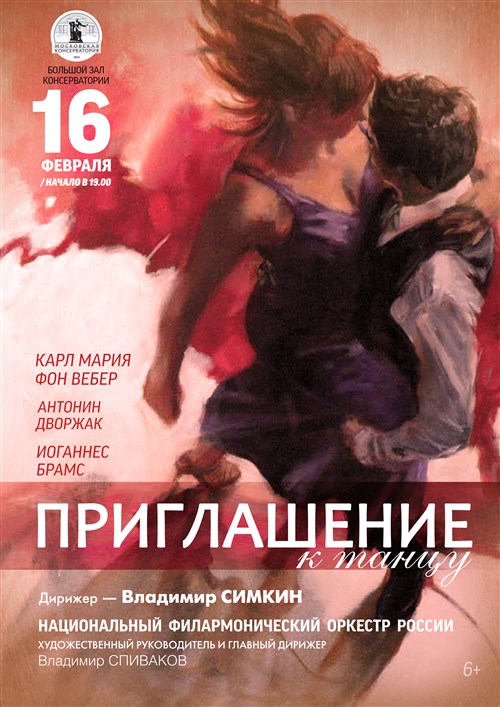February 16, 2018 | Great Hall of the Moscow Conservatory
«Invitation to Dance»
Conductor – Vladimir Simkin
Weber. Invitation to Dance (Orchestration by Berlioz)
Dvorák. Slavonic Dances, Op.46
Brahms. “Hungarian Dances”
On February 16, the National Philharmonic Orchestra of Russia invites music lovers to the Great Hall of the Moscow Conservatory for a concert which will feature the most popular symphonic dances of the 19th century. On the conductor podium this night there will be the Honoured Artist of the Russian Federation Vladimir Simkin, who has been collaborating with Vladimir Spivakov's Orchestras since 2004.
Weber's “Invitation to Dance” (Aufforderung zum Tanz), which gave the name to the concert, was written in one day on July 28, 1819. This is one of the first symphonic examples of waltz, the dance which gained immense popularity all over the world throughout the 19th century. Like many romantic works, Weber's piece is programmatic. According to the author, it describes a first encounter of a young man and a girl at a dance party. He invites her to a dance, and the brilliant waltz reveals shining hopes and joy of life in all its melodical diversity. In one of the episodes there is a dialogue (a declaration of love), and in the end a parting until the next meeting. In 1841 Hector Berlioz, a brilliant orchestra master, made a colorful orchestration of Weber's work.
No less popular are the “Hungarian Dances” by Brahms, reflecting the author's great interest in Hungarian folk melodies, which was once aroused in young Johannes by famous violin virtuoso Ede Reményi. Brahms played and travelled a lot with Reményi, a pupil of the Vienna Conservatory, who brought the art of Verbunkos and Czardas onto the concert stage, Hungarian melodies and rhythms became a symbol of overt expression of emotions and Reményi's art a paradigm of improvisational freedom for Brahms. Brahms would return to the "Hungarian dances" for many years, releasing a total of four books of them.
Dvořák's “Slavonic Dances”, written at the commission of his publisher Zimrock, were inspired by the “Hungarian Dances”. The visionary world of the "Slavonic Dances" is marked by richness and loveliness. Cheerful enjoyment and kaleidoscopic bright colors prevail in some of them, evoking associations with motley folk dresses and patterns, or festive paintings of peasant life. Others are winsome samples of poetic, soulful lyrics.




